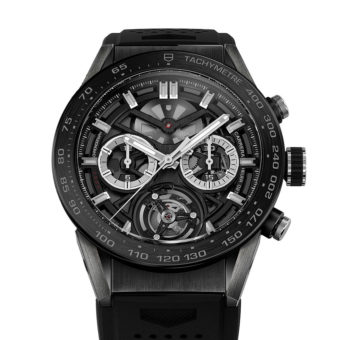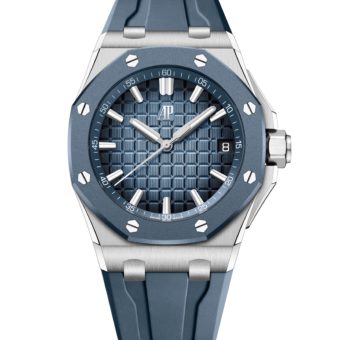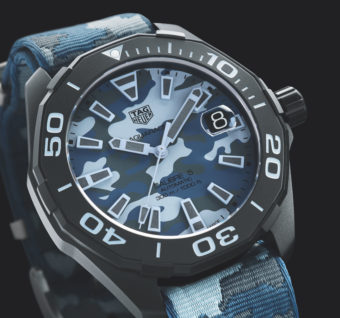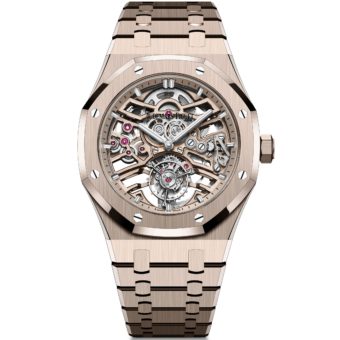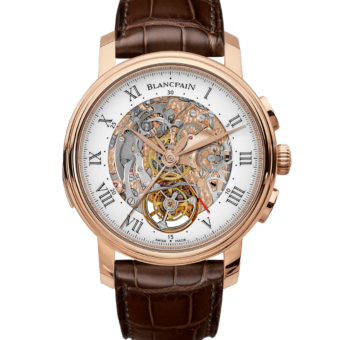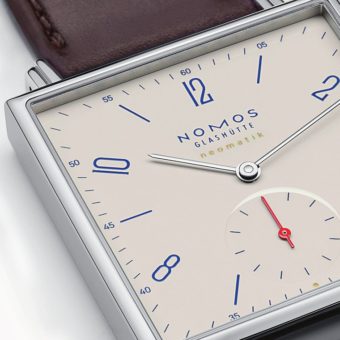
Audemars Piguet created minute repeater and grand strike pocket watches from its founding in 1875, and they claim the first minute repeater wristwatch, produced in 1892. The new Millenary Minute Repeater incorporates the manufacture’s newest technical developments: the AP escapement and a double balance-spring, as well as the striking mechanism and its gongs. The result is an auditory and visual delight for the 21st century.
The striking mechanism is the oldest of all complications. As early as the 15th century, certain pocket watches sounded the hours in passing, while quarter-repeating mechanisms striking the hours and quarters on demand appeared in the late 17th century. These watches, endowed with a mechanical memory and which initially served to tell the time in the dark, are now one of the greatest demonstrations of horological expertise, and the exclusive preserve of a few movement manufacturers.
The Millenary Minute Repeater brings this complication thoroughly up to date with the AP escapement, the double balance-spring, as well as the hammers and the striking gongs.
Drawing inspiration from a mechanism created in the late 18th century by a watchmaker named Robin, Audemars Piguet developed a new escapement combining the high efficiency of a direct-impulse escapement with the reliability of a Swiss lever escapement. The watchmakers in Le Brassus thereby succeeded in reducing the energy losses and in eliminating the need to lubricate the pallet-stones. This groundbreaking technical development in turn enhanced rating accuracy, long-term stability and shock-resistance.
Conceived, developed and produced by Audemars Piguet, the new hand-wound Caliber 2910 driving the Millenary Minute Repeater is also distinguished by the atypical construction of the regulating organ. It is composed of not of one balance spring, but of two balance-springs placed top to tail. This flat opposite-facing double balance-spring system offers numerous advantages: it ensures automatic compensation for potential poising flaws; eliminates the need for the “overcoil” terminal curves of so-called “Breguet-type” balance-springs, which are very tricky to make. It also does away with the imprecision resulting from the vertical position of the watch without resort to a tourbillon. These special features serve to ensure finer adjustment of the balance and spring assembly oscillating at a frequency of 21,600 vibrations per hour.
The oval Millenary case in brushed titanium – a material featuring exceptional resonance qualities – is framed by a polished titanium bezel. Particular attention has been paid to the hand-polished beveling, on the interior angles and on the concentric circular-grained motif. The movement is also adorned by a horizontal Côtes de Genève pattern. These many details are visible both from the top and through the transparent caseback, which together serve to highlight a compelling three-dimensional architecture.
Additional technical information appears below the images, which may be enlarged with a click.



Audemars Piguet’s first wristwatch with minute repeater, manufactured in 1892.

Reference
··26371TI.OO.D002CR .01
Movement
··Manufacture Audemars Piguet Calibre 2910
··Offset hours/minutes at 3 o’clock, offset minutes at 7 o’clock
··Three-position winding crown
··Repeater slide serving to activate the minute repeater at 7 o’clock
··Movement dimensions (width and thickness): 37.90 x 32.90 mm
··Casing diameter (width and thickness): 37 x 32 mm
··Total movement thickness: 10.05 mm
··Direct-impulse AP escapement
··Variable-inertia balance fitted with inertia-blocks
··Diameter of the balance: 11.90 mm
··Flat double balance-spring
··Power reserve: 165 hours
··Frequency: 21.600 vph (3Hz)
··Number of parts: 443
··Number of jewels: 40
··Finishing: all parts finished by hand, with hand-polished bevelling, interior angles, snailing, hand-draw file strokes, horizontal “Côtes de Genève” motif and circular-graining on the mainplate
Case
··Titanium oval case
··Width: 47 mm
··Thickness: 42 mm
··Sapphire crystal caseback
··Non water-resistant
Dial
··Anthracite grey dial, applied pink gold Roman numerals, silvered small seconds subdial
Strap
··Hand-sewn black crocodile leather “with large square scales”, fastened by a titanium AP folding clasp
Functions
··Hours
··Minutes
··Small seconds
··Minute repeater

